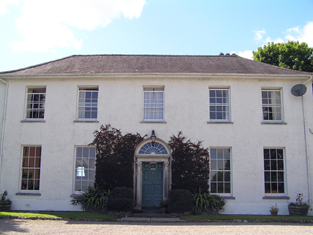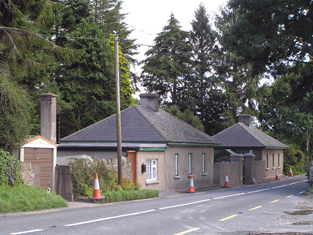Greenville
Houses within 5km of this house
Displaying 25 houses.
Houses within 5km of Greenville
Displaying 25 houses.
| House name | Description | |
|---|---|---|
| Fota House | Originally built as a hunting lodge for the Smith Barrys in the 18th century and enlarged in the 1820s to the design of Sir Richard Morrison with further 19th century additions. Valued at £89 and held by James H.S. Barry in fee at the time of Griffith's Valuation. Occupied by Lord Barrymore in 1906 and valued at £160. Inherited by Major and the Honourable Mrs Bell. The Irish Tourist Association survey provides details of some of the paintings in the house and exotic plants in the gardens. Bence Jones writes that Fota was sold to University College, Cork in 1975 following the death of Mrs Bell. It is now in the care of the Irish Heritage Trust and after restoration was reopened to the public in 2009. http://www.fotahouse.com/display.php |

|
| Ballycurrany House | This house was occupied by Joseph Wilson at the time of Griffith's Valuation. He held it from James H. Smith Barry and it was valued at £13. It is no longer extant. | |
| Ballynaclashy House | Occupied by Henry Wilson in the early 1850s, held from James H. Smith Barry and valued at £10.10 shillings. Herny Wilson of Ballynaclashy owned 83 acres in the 1870s. A house is still extant at the site. | |
| Glenview | George Courtenay is recorded as resident at Glen-View in 1814 and also in the early 1850s when he held the property from James H. Smith Barry. The buildings were valued at £9. In 2010 it was offered for sale. |

|
| Windsor House | Dominick Sarsfield was living at Windsor, Cork, in 1814 and by 1837 it was the property of J. Martin. Joseph Martin held this house valued at £13.10 shillings from the Earl of Bandon in the early 1850s. Windsor House is still extant and occupied. |

|
| Killahora House | J. Martin is recorded as resident at Killahora in 1837. At the time of Griffith's Valuation John Martin held a house valued at £25 from the Earl of Bandon. A house is still extant at this site. | |
| Union Lodge | This house was the residence of the Reverend William Gifford in 1837. At the time of Griffith's Valuation Hughes Martin was the occupier. He held the property from William Coppinger and the buildings were valued at £21. | |
| Tullagreen | Occupied by Robert Martin in 1814 and by Hughes Martin in 1837. The house was recorded as unoccupied at the time of Griffith's Valuation. Hughes Martin was the immediate lessor and the house was valued at £19+. |

|
| Garrancloyne House | This was the original home of the Coppingers of Middleton. A substantial house with a gate lodge is marked on the first Ordnance Survey map but by the time of Griffith's Valuation the house with the largest valuation in this townland was £2. It was occupied by Hughes Martin and held from William Coppinger.In 1786 Wilson refers to "Killycloyne" as a seat of the Martin family in this area. | |
| Killora Lodge | This house was the residence of Reverend R. Berry [Bury] in 1837 and was unoccupied at the time of Griffith's Valuation. Reverend Robert Bury was the immediate lessor and the buildings were valued at £20. It is still extant and occupied. |

|
| Toureen Lodge/Ashbourne | At the time of Griffith's Valuation the Reverend Robert Bury was occupying a house in this townland valued at £17 and held from the Earl of Bandon. It is labelled Toureen Lodge on the 1st edition Ordnance Survey map and as Ashbourne on the 25-inch edition of the 1890s. In the twentieth century it became famous for its well-known gardens, laid out by Richard H. Beamish. |

|
| Johnstown House | Johnstown was the home of Sarsfield Esq in the 1770s and 1780s. William Martin is recorded as resident at Johnstown in 1814 and Mrs Palmer in 1837. John Courtney occupied the house valued at £21+ in the early 1850s. He held it from the Earl of Bandon. The original house is not extant. | |
| Anngrove | Bence Jones writes that this was originally a Cotter residence, sold to the Earls of Barrymore before the mid 18th century. Dobson Esq was resident in the 1770s and 1780s. By 1814 Francis Wise was resident and was still resident at the time of Griffith's Valuation, when the house was valued at £30 and held from Sir William Clarke. The house was later inherited by the Gubbins family. Demolished post 1950. | |
| Rockville | The Barrys were inhabiting Rockville by the mid 18th century. William Barry was resident in 1814 and his seventh son Thomas Barry in 1837. In the early 1850s Garret Barry was occupying this house which he held from Sir William Clarke. It was valued at £15.15 shillings. | |
| Rossmore | Rossmore was a Coppinger home in the 19th century, the residence of Thomas Coppinger in 1814 and 1837. Thomas Francis Coppinger is recorded as the occupier at the time of Griffith's Valuation when the property, valued at £19, was held from Sir William Clarke. | |
| Barryscourt | Originally a seat of the Barry family, Earls of Barrymore, it had become a Coppinger home by the mid 18th century. Wilson refers to it as the seat of Mr. Coppinger in 1786 and also notes "the castle of Barry's Court". It was the residence of William Coppinger in 1814 and in the early 1850s, when it was held from Sir William Clarke and valued at £22. Following William's death in 1862 this property passed to his nephew Morgan John O'Connell. Bence Jones records it as a ruin but the original medieval castle has been refurbished and is now open to the public. In the 1940s the Irish Tourist Association survey included a description of both buildings. | |
| Sunville | A property held from Francis Wise in the mid 19th century by Thomas Donovan. The buildings were valued at £15.10 shillings. In the 1870s Thomas Donovan of Sunville, Johnstown owned 174 acres in county Cork. | |
| Barry's Lodge | Occupied by D. Barry in 1837 and by Henry Barry in the early 1850s. He held the property valued at £28 from Samuel Reeves. | |
| Cloneen | Leet records - Hoare esq as resident at Cloneen, Middleton, in 1814. In the mid 19th century Robert Lunham held a house valued at £20+ from Bingham Sarsfield in this townland. Sarsfield held the property from Abraham Devonsher. When Cloneen was advertised for sale in 1870 it was occupied by Joseph Sheedy. Bingham Sarsfield of Cork owned 266 acres in county Cork in the 1870s. A house is still extant at the site. | |
| Curragh | At the time of Griffith's Valuation John Courtenay held a house, offices and gate lodges at Curragh, valued at £28. The first Ordnance Survey map shows a farm yard for Ballyedmond in Curragh. The 25-inch map of the 1890s still indicates extensive farm buildings, together with kennels. Farm buildings remain at the site. | |
| Ballyedmond | Ballyedmond passed through marriage from the Brownes to the Courtenays. Robert Courtney was the proprietor of Ballyedmund in 1814. John Courtenay held Ballyedmond from the Reverend William Halloran in the mid 19th century. The buildings were valued at £199. The seat of Robert Courtney Smith-Barry in 1894. Inherited by the Smith Barrys and sold by them in the 1960s. The house no longer exists but much estate architecture including gate lodges survives. |

|
| Springhill | This house was a Wakeham home from at least the mid 1770s. William Wakeman was resident at Springhill in 1814 and W.J. Wakeham in 1837. Joseph B. Wakeham held Springhill in fee at the time of Griffith's Valuation when the buildings were valued at £15+. | |
| Ballyvodock | Thomas Wigmore occupied this house in the mid 19th century. He held it from the representatives of Viscount Midleton and it was valued at £9+. | |
| Ballyvodock House | James Barry was living at Ballyvodig House, Middleton, in 1814. In the mid 19th century William Kelleher was the occupier. He held the property from William Oliver Jackson and the buildings were valued at £11. A house and large farm are still extant at the site. | |
| Ballintubbrid House | Ballintobrid, Middleton, was the home of William Weekes in 1814. By 1837 it was the home of the Heard family and occupied and held by Edward Heard in fee at the time of Griffith's Valuation. The house was valued at £13. The original house is not extant. |

